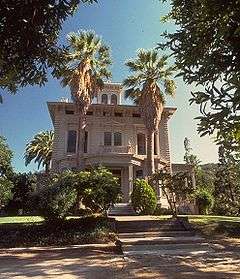John Muir National Historic Site
|
John Muir National Historic Site | |
 | |
  | |
| Location | 4202 Alhambra Avenue, Martinez, California |
|---|---|
| Coordinates | 37°59′29″N 122°08′00″W / 37.991311°N 122.133298°WCoordinates: 37°59′29″N 122°08′00″W / 37.991311°N 122.133298°W |
| Area | 345 acres (140 ha) |
| Built | 1849 |
| Architect | Wolfe & Son; Martinez, Vicente |
| Architectural style | Italianate-Victorian[2] |
| Visitation | 28,166 (2005) |
| Website | John Muir National Historic Site |
| NRHP Reference # | 66000083[3] |
| CHISL # | 312[4] |
| Significant dates | |
| Added to NRHP | October 15, 1966 |
| Designated NHL | December 29, 1962[5] |
| Designated NHS | August 31, 1964[2] |
The John Muir National Historic Site is located in the San Francisco Bay Area, in Martinez, Contra Costa County, California. It preserves the 14-room Italianate Victorian mansion where the naturalist and writer John Muir lived, as well as a nearby 325 acres (132 ha) tract of native oak woodlands and grasslands historically owned by the Muir family. The main site is on the edge of town, in the shadow of State Route 4, also known as the "John Muir Parkway".[6]
History
Mansion
The mansion was built in 1883 by Dr. John Strentzel, Muir's father-in-law, with whom Muir went into partnership, managing his 2,600-acre (1,100 ha) fruit ranch. Muir and his wife, Louisa, moved into the house in 1890, and he lived there until his death in 1914.

Conservationist
While living here, Muir realized many of his greatest accomplishments, co-founding and serving as the first president of the Sierra Club,[7] in the wake of his battle to prevent Yosemite National Park's Hetch Hetchy Valley from being dammed, playing a prominent role in the creation of several national parks, writing hundreds of newspaper and magazine articles and several books expounding on the virtues of conservation and the natural world, and laying the foundations for the creation of the National Park Service in 1916.
The home contains Muir’s "scribble den," as he called his study, and his original desk, where he wrote about many of the ideas that are the bedrock of the modern conservation movement.[8]
Archive and Landmark
The Muir house was documented by the Historic American Buildings Survey in 1960.[9]
It became a National Historic Site in 1964, is a California Historical Landmark #312 and National Historic Landmark, and is on the National Register of Historic Places.
In 1988 nearby Mount Wanda Nature Preserve was added to the Historic Site.[10]
John Muir National Historic Site
The John Muir National Historic Site offers a biographical film, tours of the house and nature walks on Mount Wanda.[11]
See also
- National Register of Historic Places listings in Contra Costa County, California
- History of the Yosemite area
References
- ↑ "John Muir Home". Office of Historic Preservation, California State Parks. Retrieved 2012-09-05.
- 1 2 "National Survey of Historic Sites and Buildings" (PDF). National Register of Historic Places. Retrieved 13 April 2012.
- ↑ National Park Service (2008-04-15). "National Register Information System". National Register of Historic Places. National Park Service.
- ↑ "John Muir Home". Office of Historic Preservation, California State Parks. Retrieved 2012-09-05.
- ↑ "John Muir House". National Historic Landmark Program. Retrieved 13 April 2012.
- ↑ "Directions". John Muir National Historic Site, National Park Service. Retrieved 13 April 2012.
- ↑ "The John Muir Exhibit". Sierra Club. Retrieved 13 April 2012.
- ↑ "Museum Collections at the John Muir National Historic Site". National Park Service Museum Management Program. Retrieved 13 April 2012.
- ↑ "John Muir House". Historic American Buildings Survey, Library of Congress. Retrieved 13 April 2012.
- ↑ "Testimony before the Subcommittee on National Parks" (PDF). National Park Service. Retrieved 13 April 2012.
- ↑ "Things To Do". John Muir National Historic Site, National Park Service. Retrieved 13 April 2012.
External links
- Official website
- John Muir National Historic Site, National Park Service at Google Cultural Institute
- National Park Service Discover Our Shared Heritage Travel Itinerary: "Early History of the California Coast"
- John Muir Association
- Historic American Buildings Survey (HABS) No. CA-1890, "John Muir House, Alhambra Boulevard, Martinez, Contra Costa County, CA"
- official U.S. National Park Service Juan Bautista de Anza National Historic Trail website
- "John Muir National Historic Site". Geographic Names Information System. United States Geological Survey.

